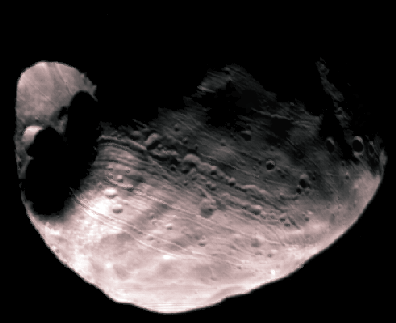Explanation: Mars, the red planet named for the Roman god of war, has two tiny moons, Phobos and Deimos, whose names are derived from the Greek for Fear and Panic. These Martian moons may well be captured asteroids originating in the asteroid belt between Mars and Jupiter or perhaps from even more distant reaches of the Solar System. In this 1977 Viking orbiter image, the largest moon, Phobos, is seen to be a heavily cratered asteroid-like object. It is about 17 miles across and zips through the Martian sky completing an orbit in less than 8 hours. Phobos is doomed. It orbits so close to Mars, (about 3,600 miles above the surface compared to 250,000 miles for our Moon) that gravitational tidal forces are dragging it down. In 100 million years or so it could crash into the surface or be shattered by stress caused by the relentless tidal forces, the debris forming a ring around Mars.
1999 2000 2001 2002 2003 2004 2005 2006 2007 2008 2009 2010 2011 2012 2013 2014 2015 2016 2017 2018 2019 2020 2021 2022 2023 2024 2025 |
Январь Февраль Март Апрель Май Июнь Июль Август Сентябрь Октябрь Ноябрь Декабрь |
NASA Web Site Statements, Warnings, and Disclaimers
NASA Official: Jay Norris. Specific rights apply.
A service of: LHEA at NASA / GSFC
& Michigan Tech. U.
|
Публикации с ключевыми словами:
Mars - Phobos
Публикации со словами: Mars - Phobos | |
См. также:
Все публикации на ту же тему >> | |
